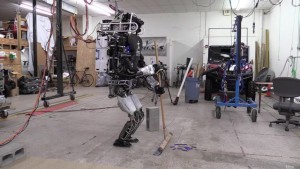A YouGov survey for the British Science Association has revealed that one in three people believe the rise of artificial intelligence (AI) is a threat to humanity.
And as a sector which has rapidly expanded in the past couple of decades, it’s easy to forget just how far robotics and tech has come. Twenty years ago, arguments were taking place at robotics conferences across the world regarding the impossibility of a robot walking, yet within 15-20 years, this impossibility has become reality.

Atlas, the autonomous robot has two legs, two arms, and knows how to work a broom.
The end of the chore?
In the home, the development of robotics is welcomed. According to the British Science Association, nearly half of people would feel comfortable with robotics help with household tasks, especially for those unable to complete chores due to age or disability.
Once a figure of futuristic imagination, the household robot could soon be welcoming us home. Boston Dynamic, together with Florida’s Institute for Human and Machine Cognition, recently showcased their latest invention – Atlas. The autonomous robot has two legs, two arms, and knows how to work a broom. It’s likely we won’t have to wait long to see smart robots integrated in households across the world.
The Chappie-effect
The BSA findings go on to show 46% of people oppose the development of robots with emotions. But, as developments into robotic intelligence are already happening, is AI which is programmed to think for itself really that far away?

The 2015 film ‘Chappie’ focused on the development of robotics which can think and feel for themselves.
Studies across the world have taken place proving this level of AI is closer than we think, including one study in which a computer managed to fool a police interrogator (behind a screen) into thinking it was human. In addition, the development of driverless cars ‘learning’ and reacting to traffic ahead is already in play.
And in the medical sector, huge steps are being taken to combine human ability with robotics, including the development of a fully functioning brain (grown in a Petri dish from rat embryos) which can be implanted into a robotic body. A concept supported by Dr Kevin Warwick of Coventry University who, through an implant in his arm which was connected to his nervous system, was able to control – and feel – a robot hand just through thinking.
With robotic limbs already widely accepted, and the 18-24 generation and innovators of the future most open to accepting this technology, could the likes of ‘’Chappie’ be closer than we think?
So is this the start of the end?
Over a third (36 per cent) of those surveyed by the BSA believed that AI poses a threat to the long term survival of humanity.
The motoring, financial and medical industry are all benefiting enormously from advancements in robotics – advancements which are more than welcomed.
The ultimate challenge to the development of robotics is not the level of innovation itself, but the social acceptance of the technology, and the scariest thing is that we don’t know what we don’t know.
